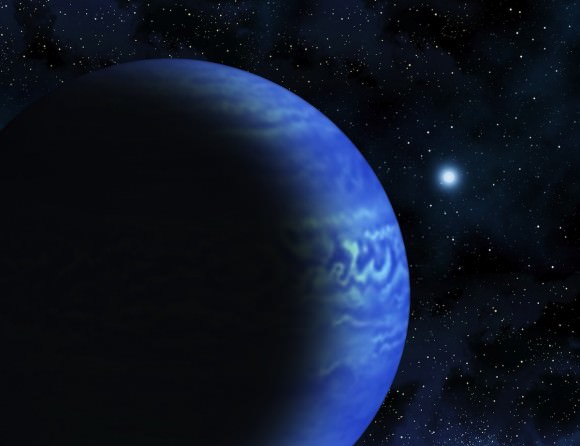
Artist's impression of a brown-dwarf object (left foreground) orbiting a distant white dwarf --the collapsed-core remnant of a dying star. Credit: Janella Williams.
Astronomers have located a planet-like star that’s barely warmer than a balmy summer day on Earth… it’s literally the coldest object ever directly imaged outside of our solar system!
WD 0806-661 B is a brown “Y dwarf” star that’s a member of a binary pair. Its companion is a much hotter white dwarf, the remains of a Sun-like star that has shed its outer layers. The pair is located about 63 light-years away, which is pretty close to us as stars go. The stars were identified by a team led by Penn State Associate Professor of Astronomy and Astrophysics Kevin Luhman using images from NASA’s Spitzer Space Telescope. Two infrared images taken in 2004 and 2009 were overlaid on top of each other and show the stars moving in tandem, indicating a shared orbit.

These two infrared images were taken by the Spitzer Space Telescope in 2004 and 2009. They show a faint object moving through space together with a white dwarf. Credit: Kevin Luhman, Penn State University, October 2011. (Click to play.)
Of course, locating the stars wasn’t quite as easy as that. To find this stellar duo Luhman and his team searched through over six hundred images of stars located near our solar system taken years apart, looking for any shifting position as a pair.
The use of infrared imaging allowed the team to locate a dim brown dwarf star like WD 0806-661 B, which emits little visible light but shines brightly in infrared. (Even though brown dwarfs are extremely cool for stars they are still much warmer than the surrounding space. And, for the record, brown dwarfs are not actually brown.) Measurements estimate the temperature of WD 0806-661 B to be in the range of about 80 to 130 degrees Fahrenheit (26 to 54 degrees C, or 300 – 345 K)… literally body temperature!
“Essentially, what we have found is a very small star with an atmospheric temperature about cool as the Earth’s.”– Kevin Luhman, Associate Professor of Astronomy and Astrophysics, Penn State
Six to nine times the mass of Jupiter, WD 0806-661 B is more like a planet than a star. It never accumulated enough mass to ignite thermonuclear reactions and thus more resembles a gas giant like Jupiter or Saturn. But its origins are most likely star-like, as its distance from its white dwarf companion – about 2,500 astronomical units – indicates that it developed on its own rather than forming from the other star’s disc.
There is a small chance, though, that it did form as a planet and gradually migrated out to its current distance. More research will help determine whether this may have been the case.
Brown dwarfs, first discovered in 1995, are valuable research targets because they are the next best thing to studying cool atmospheres on planets outside our solar system. Scientists keep trying to locate new record-holders for the coldest brown dwarfs, and with the discovery of WD 0806-661 B Luhman’s team has done just that!
A paper covering the team’s findings will be published in The Astrophysical Journal. Other authors of the paper include Ivo Labbé, Andrew J. Monson and Eric Persson of the Observatories of the Carnegie Institution for Science, Pasadena, Calif.; Didier Saumon of the Los Alamos National Laboratory, New Mexico; Mark S. Marley of the NASA Ames Research Center, Moffett Field, Calif.; and John J. Bochanski also of The Pennsylvania State University.
Source: Universe Today
No hay comentarios:
Publicar un comentario